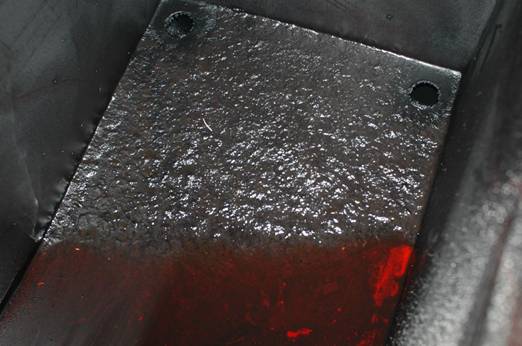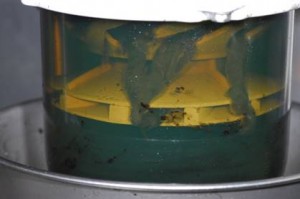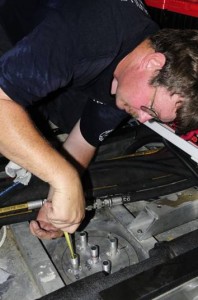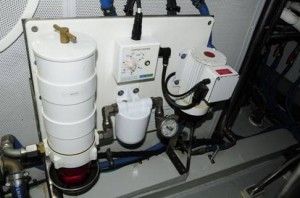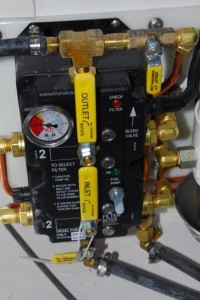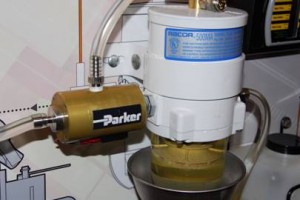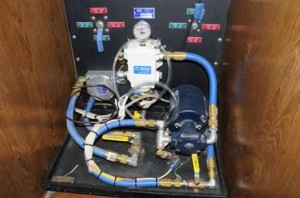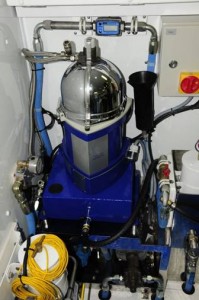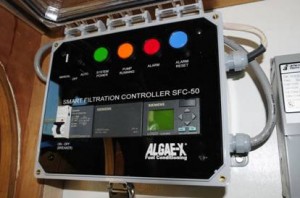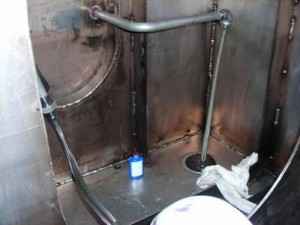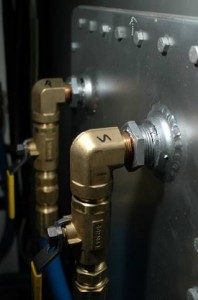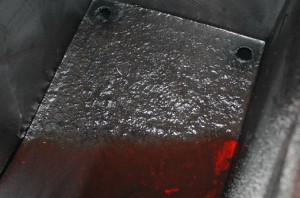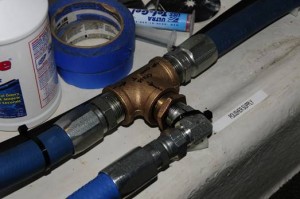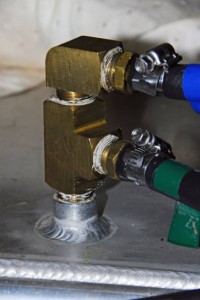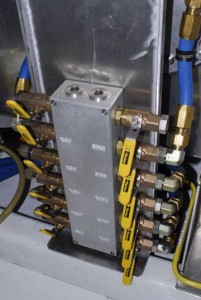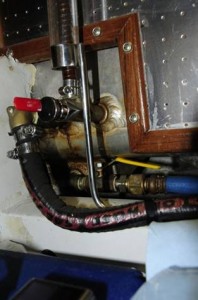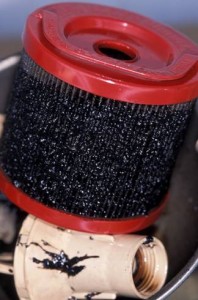Fuel Polishing Systems Explained
By Steve D’Antonio
Copyright September 2013
Seaweed-like tendrils, similar to those shown here, are a sure sign of water contamination Among other things, polishing systems that are properly plumbed will prevent this problem.
I attend many boat shows and marine trade exhibition each year, from the Miami and Ft. Lauderdale Shows to the International Boat Builders’ Exhibition (IBEX) in Louisville, Kentucky, and the Marine Equipment Trade Show (METS) in Amsterdam, the Netherlands. At each show I encounter what seems to be an increasing variety of new and interesting products. The exhibitor’s floor and tents are a veritable gearhead’s candy store, row upon row of interesting gear in booths that are more often than not staffed by knowledgeable personnel who enthusiastically talk about the products they represent and in many cases invent and build themselves.
Fuel polishing systems have become exceptionally popular, and the space dedicated to their display seems to increase with each passing year. I delivered a lecture on the subject at IBEX a couple of years ago and the questions from the audience, mostly builders and boat yard folks, were excellent and plentiful. This demonstrated to me, however, that even the professionals are not clear on the preferred installation approaches or the differences in the available systems, and make no mistake about it, the differences are truly vast.
Plumbing is by far the most challenging aspect of any polishing system installation. It is invariably the cause of most performance problems.
The quality and effectiveness of these systems runs the gamut, from those that perform as advertised (while going easy on the hype) to those that promise the world and then some and often don’t deliver. I intentionally make it a point of engaging the folks representing the products that I encounter, asking them questions about what they do, how they work, how they should be installed etc. (I often flip my name tag over when doing so). The responses are interesting. Many representatives know their products inside out and are honest and realistic about what they could be expected to do where fuel and contamination issues were concerned. A few, however, make wild claims, often while bashing their competitors’ products, about how their systems were capable of solving all fuel ills, including cleaning the fuel as well as seriously contaminated tanks. The former should be a given, the latter is virtually impossible.
High capacity polishing systems like the one shown here, are often palletized, they include filter, high volume pump, and a control mechanism or timer, along with a vacuum gauge.
The profusion of polishing in the past decade is an indication of the need, or perceived need, for added fuel filtration. It is, however, undeniable that fuel contamination, and the problems is causes, are a very real issue for many diesel-powered vessels.
At the other end of the spectrum from high volume pumps, this prototype Lilliputian supplemental filtration system works by filtering fuel at a very low volume, albeit continuously.
Most high volume polishing systems rely on either geared, like the one shown here, or multi-chamber diaphragm pumps. The plumbing used must be of sufficient diameter to accommodate the flow rate of these pumps.
The mother of all polishing systems, centrifuges are capable of slinging water and dirt out of fuel down to a single micron, and they do so using centrifugal force rather than filter elements.
Nearly as important as the filtration itself, the display and controls enable users to operate, and monitor the polishing system, in this case remotely.
With the increase in shear volume of fuel polishing systems it’s inevitable that there will be differences. The good news is, from my perspective nearly all of them are or would be effective to some extent at removing some contamination. Beyond that, however, things get somewhat hazy. My own personal criteria for fuel polishing systems are, among other things, that they maintain not only the cleanliness of the fuel but the tank as well.
In order to work effectively, polishing system pickup and return plumbing must be plumbed to opposite ends, and always to the bottom, of a tank. In some cases, depending upon access, that plumbing may be run internally, like that shown here.
In order to do so, they must utilize a pump whose volume is significant, on the order of at least 100 gallons per hour. This pump capacity ensures meaningful movement of fuel through the tank, which is a critically important aspect of a fuel polishing system, particularly for vessels that spend much of their time at rest. Thus, capacity or volume matters when comparing fuel polishing systems.
Remember, this is just my definition, any person or manufacturer can plumb and wire a small electric fuel pump to an equally small filter and call it a polishing system, there’s no official definition. And, they can install it by “paralleling” the pick up and return plumbing to the tank’s and engine’s existing ports.
If polishing system supply and return fittings are located close together, a common installation fault, fuel will “short cycle”, moving primarily between these two fittings, rather than across the bottom of the tank.
The fuel can be filtered when the engine is not running, which could be construed as polishing. Indeed, all fuel filtration is good. If you choose a low volume polishing system, what I like to call, and not in a disparaging way, supplemental filtration, you are certainly on the right track. All filtration is good.
However, don’t expect it to perform in the same manner as a high volume system. Roughly speaking, supplemental filtration systems are most effective at cleaning the fuel rather than maintaining the cleanliness of the tank. This is strictly a function of their low volume pumping action. If the vessel is underway frequently and the fuel within the tank remains agitated, which prevents a phenomenon known as agglomeration (small suspended particles attract each other, forming larger agglomerates, which then sink to the tank bottom) and settling of heavier contaminants such as water and asphaltine, then supplemental filtration will often do a creditable job of keeping the fuel clean.
A seriously contaminated fuel tank; the material on this tank’s bottom is likely the result of years’ worth of agglomeration, a process whereby small particles suspended within the fuel attach to each other and then sink. This type of accumulation is notorious for quickly clogging filters when vessels afflicted with it enter a seaway. While it is the primary mission of a polishing system to prevent this type of buildup, polishing systems installed after it has accumulated are no match for its tar-like consistency. Contrary to the claims of some polishing system manufacturers, and dockside cleaning services, its removal is an arduous job that can only be accomplished by scooping, scrubbing and washing, a process which requires access to every baffled chamber of the tank.
If, however, the vessel remains at rest for long stretches of time, then supplemental filtration is likely to be less effective than a high volume polishing system. Additionally, a high volume polishing system should be sized and installed so it passes all of the fuel in the tanks through its filter three times in a “reasonable” amount of time. Reasonable is open to interpretation, however, my definition is eight to ten hours. Thus, a supplemental filtration system may find itself “challenged” when mated to a large tank or tanks.
Like fuel plumbing for the engine, polishing system plumbing must be robust, leak-proof and flame resistant.
In addition to the selection of the polishing or supplemental filtration systems themselves, the other hurdle frequently faced by those purchasing these systems is obtaining or ensuring proper installation. Even the best, high volume polishing system will be of little value if it’s not properly plumbed to the vessel’s fuel tanks, in a manner that takes maximum advantage of the systems flow rate. This is especially important for high volume polishing systems. In order for them to work most effectively they must be plumbed using dedicated fittings that share no part of the tank’s or engine’s/generator’s existing fuel system.
A textbook example of paralleling, sharing fuel pick up and return fittings with the vessel’s main engine. This approach severely restricts a polishing system’s capabilities, as well as potentially starving an engine of fuel, and should therefore be avoided.
This is necessary for two reasons. One, existing fuel plumbing is nearly always too small for high volume polishing pumps, polishing systems often require plumbing as large as ¾ inch inside diameter. Two, the location in the tank of existing pickup and return fittings is nearly always detrimental to the efficiency of a polishing system.
When a polishing system is plumbed to more than two tanks a manifold is typically employed.
Polishing system pick up and return fittings should be located as far apart as possible, preferably at opposite ends of the tank, ensuring maximum movement of fuel. And, the polishing system pickup should be close to the bottom of the tank, closer than the primary engine pick up, ensuring that it removes all or as much water and debris as possible.
Polishing system pick up fittings should be located at the absolutely bottom of a fuel tank. While appropriate for supplying fuel to an engine, fittings like the one shown here are not low enough for polishing system use.
Finally, where installation plumbing is concerned, the return fitting must be equipped with a drop tube. This ensures maximum turbulence at the bottom of the tank where debris invariably accumulates and it avoids aeration of the fuel, which hastens its degradation and increases the risk of erratic engine operation.
Where supplemental filtration is concerned, large diameter plumbing is not an issue, however, paralleling filtration with engine fuel supply can lead to problems and, the fuel can short cycle between the pick up and the return within the tank, minimizing how much fuel is actually filtered.
While a polishing system is no substitute for conventional primary and secondary fuel filters, when one is installed and used regularly, replacement intervals for these filters are nearly always extended.
The elephant in the room that I haven’t addressed is expense. High volume polishing systems that are properly plumbed to fuel tanks in the manner described are nearly always expensive affairs, typically in excess of $10,000 installed (often less if carried out during the vessel’s construction), while supplemental filtration systems are often a tenth of that. If this simply isn’t in your budget, or if you have a smaller tank or if your vessel is used frequently (keeping the fuel agitated and contamination in suspension), you may opt for the considerably less expensive but possibly less effective supplemental filtration route. Remember, when it comes to diesel fuel, all filtration is good, and the more you have the better. Not every vessel needs a polishing system. More importantly, however, if you do choose to install one, make certain you understand what it can, and cannot be expected to do.
For more information on the services provided by Steve D’Antonio Marine Consulting, Inc. please e mail Steve at info@stevedmarineconsulting.com
or call 804-776-0981

